What are the Types of Attic Ventilation Systems?
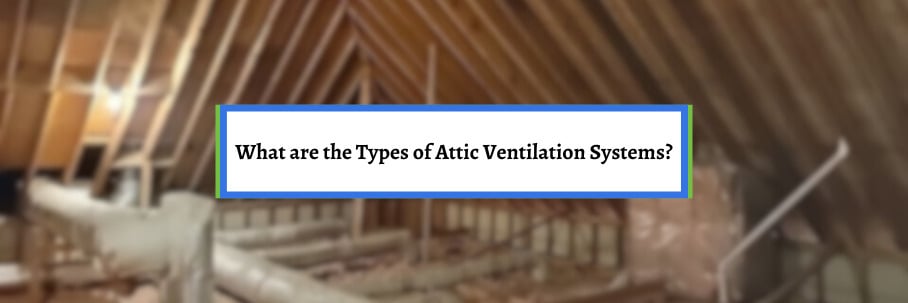
When you think about your roof, you probably don’t think about your attic. However, your attic has a ventilation system that has a big impact on your home.
In fact, it could be the reason your energy bills are way too high in the hotter months. On top of this, not having enough ventilation can ruin your roof investment and lead to premature failure.
This is the last thing you want to happen. And the first step to ensure you have a properly ventilated attic is to simply know how it works and the difference between the two systems.
For over 30 years, Bill Ragan Roofing has taken pride in helping homeowners understand attic ventilation and its impact. So, let’s break down the two types of attic ventilation systems.
By the end of this article, you’ll have answers to:
- What does an attic ventilation system do?
- What are the types of attic ventilation systems?
- Which attic ventilation system is best?
What does an attic ventilation system do?
Your attic’s ventilation system allows your home to breathe by recycling the air in your attic. It works by pulling fresh air into the attic through intake vents while pushing the trapped air through exhaust vents on the roof.
However, the type of ventilation system determines how this is done (more on this next). But no matter which one you have, it’s absolutely crucial that your attic has the right amount of ventilation.
I guarantee your roof’s life will be cut short, and your home won’t be as energy efficient if it isn’t.
What are the types of attic ventilation systems?
The two types of attic ventilation systems are active ventilation and passive ventilation. The name for each is based on how it moves the air in and out of your attic.
Both ventilation systems do the job as long as it’s done correctly. However, they function differently and have different types of roof vents that help them do the job.
Active ventilation
Active ventilation “actively” moves air in and out of your attic with moving parts or using power. It works by creating a drawing effect when the intake vents pull fresh air while actively pushing the air in your attic out through the exhaust vents.
Because this system doesn’t rely solely on natural sources, it actively works to ensure the air in your attic is moved in and out on a regular basis. However, the specific vent determines how exactly an active ventilation system works.
Let’s look at common active roof vents and how they work.
Turbine roof vents
Turbine vents (also known as whirly birds) use a drawing effect combined with convection (heat rising) to pull air in and out of an attic. They do need wind to be fully effective, but natural convection still moves air in and out on calm days.

However, the vent itself still actively pulls air into an attic and moves it around 10-12 times per hour. The slats make them open-aired in the attic, but rain, snow, and insects can only get through if the vent is damaged or installed incorrectly.
Power roof vents
Power roof vents are circular-shaped vents powered by electricity installed near a roof’s ridge. This vent uses power to pull cool air in and push the hot air from the attic.
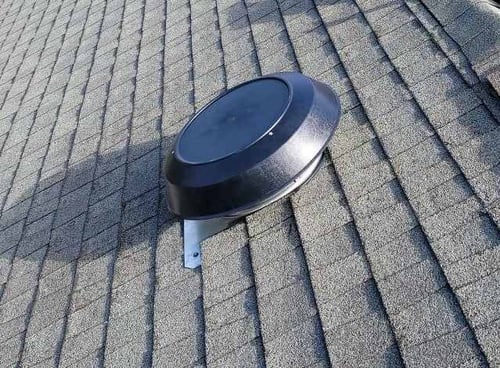
The only big drawback is that power vent motors fail eventually, which means replacing them at some point. An electrician will also have to actually hook it up after the roofers install it for safety and insurance purposes.
Solar powered roof vents
Solar-powered vents are pretty much power vents, but they use solar energy from the sun. These vents are great from an energy-saving standpoint, but they don’t hold a charge long enough to run all day.
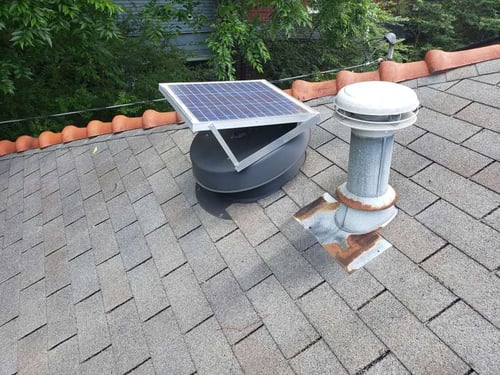
They also turn off while charging, which means your air conditioner may run more while the battery recharges.
Ridge vents with a baffle
A ridge vent (also called filtered) runs horizontally across the peaks (ridges) to let air escape through the top of your roof. It’s cut directly into the roof ridge and goes all the way across the roof to provide plenty of space to push hot air out.
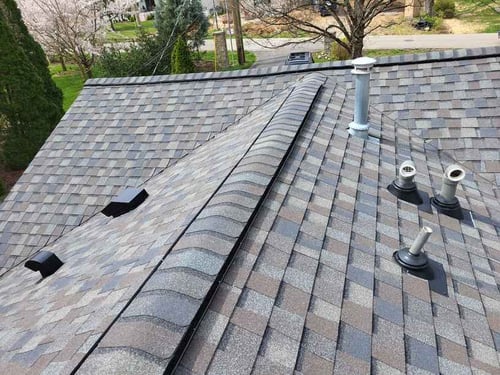
They are extremely popular because they aren’t noticeable from the ground. However, a ridge vent is only active if it has a baffle (filter) that provides a channel for air to flow.
It also acts as a filter to prevent insects, debris, rain, and snow from entering the attic.
Passive ventilation
Passive ventilation uses natural forces such as wind and convection to move air in and out of an attic. Unlike active ventilation, passive ventilation has no moving parts moving the air around.
This means there’s nothing in place to ensure it’s actively working throughout the day. That’s why passive ventilation is seen as less efficient than active ventilation.
However, it still does the job well as long as the roof has the right number of vents. With that in mind, let’s look at common passive roof vents.
Box roof vents
Box roof vents (also called static, turtle, and louver vents) look like little boxes sitting on a roof. They let air escape as heat in an attic rises and pushes the hot air through the vents.
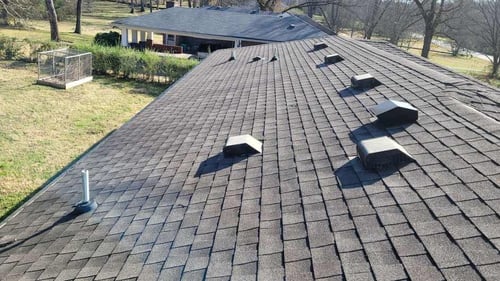
Box roof vents are commonly used on roofs where the ridge doesn’t extend all the way across. They aren’t as effective as active vents, which is why they require more physical vents to properly ventilate an attic.
Some homeowners avoid box vents because they don’t want to see them scattered across their roof.
Ridge vents without a baffle
Like the active version, a ridge vent is cut directly into the roof’s ridge and runs the entire length. The only difference is that there’s no baffle or filter to prevent debris, rain, snow, or insects from entering your attic.
However, it still pushes out plenty of hot air because it goes across the entire roof ridge. While there’s nothing wrong with getting this ridge vent, I recommend spending the extra money to get the filter.
Gable end vents
A gable end vent is a wooden vent on an attic’s exterior wall below where the two slopes of a roof meet. It relies on wind coming from outside to move the air in and out of your attic using horizontal ventilation.

If both sides of the attic have gable end vents, air can come in one side and exit out the other side. However, it’s also common to see one on the exterior wall paired with a ridge vent on the roof.
Unfortunately, the cross breeze created by horizontal ventilation hinders the effectiveness of the roof ridge’s vertical ventilation. That’s why gable ends are falling out of fashion on new builds.
Which attic ventilation system is best?
As I said earlier, both systems do the job as long as the attic has enough ventilation. An active ventilation system is more efficient, so I recommend it over passive ventilation.
There’s nothing wrong with a passive system as long as it has the correct number of vents. I just prefer active for the functionality and regular intervals of moving air around an attic.
However, it also depends on the situation. So, a certain ventilation system or specific roof vents may be a better fit based on your roof and home.
How does attic ventilation actually impact your roof and home?
Now you know the two types of attic ventilation systems, how they work, their roof vent options, and which one I prefer. But remember, one ventilation system isn’t better than the other.
The most important thing is that your attic has the right amount of ventilation. If it doesn’t, you’ll have serious problems.
But what problems come with a poorly ventilated attic? And what kind of impact does it actually have?
I can’t overstate just how important proper ventilation is. That’s why I wrote another article breaking it all down.
Check out Why is Proper Attic Ventilation Important to Your Roof and Home to learn why having an attic with the right amount of ventilation is crucial.


